Marginality as a Space of Freedom
Some Notes on the Popularity of Naïve Art Among Soviet Painters in the 1960s and 1970s
The term ‘marginality’ initially appeared in American sociological theory in the 1920s to describe the behavior of groups of immigrants who were living on the border of two cultures. Accepting the main rules of lifestyle customary among Americans, they also preserved many traits of their local tradition; thus, they could assimilate different elements of these two cultures. [1] In the end of the 1960s, after the civil unrests and strikes in Europe and the USA, the meaning of the term ‘marginality’ became associated with a program of escapism and protest against the sociocultural norms dictated by the establishment. [2]
Movements like the hippie phenomenon were uncommon within the Soviet Union at the turn of the 1960s and 1970s, but this period was nonetheless marked by rising disappointment in the politics of the Communist party among the Russian intellectual and creative milieu. The origins of this process have been repeatedly discussed by both Russian and international scholars. [3] It is common to speak about a conservative turn taken by the new state leader Leonid Brezhnev in 1964. Brezhnev’s cultural policy was marked by a campaign against ‘the blackening of the Soviet past,’ a number of arrests of the dissidents, and an increase of censorship. Alienation from the West, an absence of international exhibitions, and a lack of information about contemporary art led Soviet artists to cultural isolation.
The peak of the crisis in the relationship between the government and intellectuals, however, is usually dated to 1968. It is concerned with the incursion of the Soviet tanks into Czechoslovakia and the repression of the Prague Spring. Although there was only one public protest, involving eight Moscow citizens in Red Square, many intellectuals were shocked by the intervention and described it as the final failure of the Thaw. [4]
A hidden disbelief in the state political system was common among artists. The Soviet art scene, homogeneous during the Stalin era, began to crack apart in a number of places after the 1953 death of that dictator. Several groups and studios that did not accept the officially supported method of Socialist Realism surfaced in Moscow. In the mid-1960s, their activity was prohibited, and the activists went underground.
Another artistic community, considered by scholars as marginal, consisted of non-professional or naïve artists. By the 1970s, naïve art had become quietly popular among Soviet artists. Art historian Ksenya Bogemskaya noted: “By their existence, a primitive, naïve artist, or an outsider, confirmed the possibility of creating, free of the social rules, norms and canons of officially confessed art.” [5] According to Bogemskaya, naive artists could “slide out of surrounding trite reality” into the world of “free creativity.” [6]
This paper focuses on another phenomenon that has traditionally been interpreted by researchers as a sort of ‘official art.’ The artists whose works are analyzed in this article had academic educations, were members of the Union of Artists, and participated in official exhibitions. This is why art critics still commonly blame them for conformism and interpret their pieces as Socialist Realism. [7] This perspective raises doubts and forces researchers to pay closer attention to the processes and tendencies within the Union of Artists in the 1960s and 1970s.
A careful study of Union archives, as well as published and oral memoirs of its members, overthrows the binary view of ‘official’ and ‘non-official’ art. In the pages of these documents, the Union of Artists appears as a large community consisting of several separate or even warring groups and masters. In the 1960s, many of the so-called official artists declined to work to promote ideological propaganda. Instead, they were inventing their own depoliticized mythology. A passion for non-professional and folk masters, which included imitating their manner and borrowing their subjects, was a part of this tendency. This paper describes the preconditions of this phenomenon and shows the particular features adopted by these artistic professionals. Finally, it discusses the political content of this stylization strategy and compares it to practices of the ‘non-official’ artists.
A number of important preconditions exist for the circumstances described above. First, the idea of mass education was popular with the state bureaucracy, which sponsored art studios and clubs for workers. Although the program of such education was based on academic examples, its control over non-professional artists was not particularly rigid. By the end of the 1960s, Soviet art historians began to study naïve art, traveling through the country searching for unknown talent, then showing the work of artists they discovered at exhibitions in Moscow.
The second important precondition was the publishing of The Decorative Art magazine, which was founded in 1957. In its pages, much attention was paid to traditional handicrafts and to the activities of contemporary folk masters. Each issue included a section dedicated to old decorated toys, carved spinning-wheels, and other utensils from pre-Soviet everyday life. All these objects were described as valuable pieces of art with their own logic and aesthetics. This optic was new and innovative, because during the previous period, decorative and applied art had not been taken seriously.
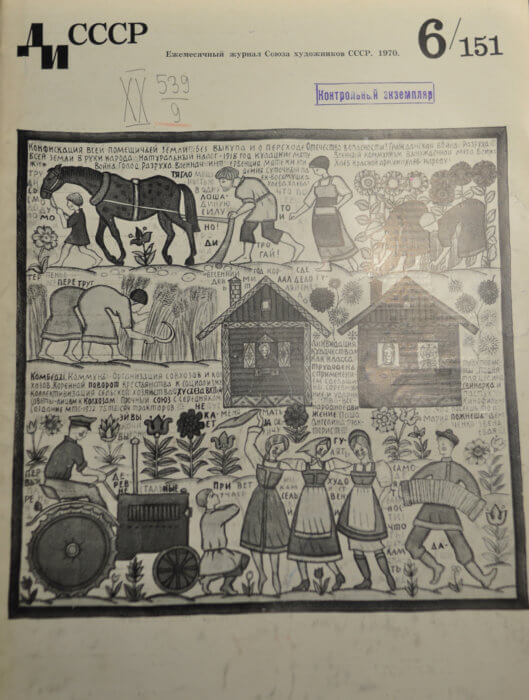
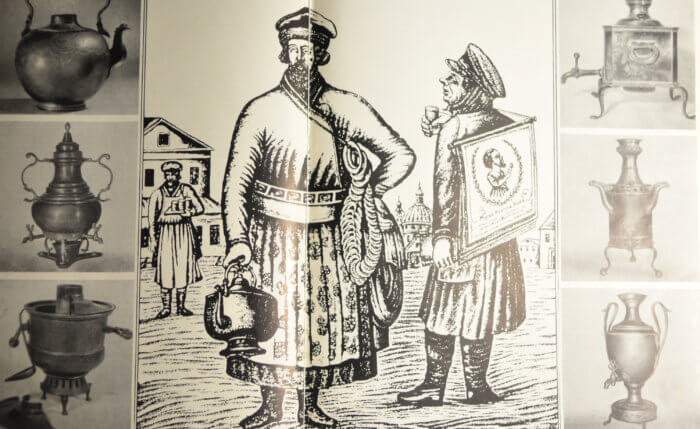
The final precondition was a 1965 edition of a book by Mikhail Bakhtin, The Art of Francois Rabelais and Folk Culture During the Middle Age and Renaissance. [10] Bakhtin described carnival as a form of a folk culture that represented the world as upside down, the purpose of which was “to build another, second life on the other side of everything official.” [11] He wrote: “No dogmatism, no authoritarianism, no primitive seriousness could get along together with the images invented by Rabelais, those images that were antagonistic to any completeness and stability, to any definitiveness in thoughts and ideologies.” [12] The oppositions of informal and dogmatic, ‘non-official’ and authoritarian seemed to be a reality for the Soviet art scene.
We cannot assert that artists who practiced stylization in the 1960s were familiar with this book, but they certainly knew the ideas it proclaimed. Bakhtin provided the impulse for a number of studies and reports on the role of folk culture. Art historian Valery Prokofiev also particularly criticized the “academic idea” of art for its belief in “a certain standard of art perfection.” In his mind, primitive art added “a fruitful element of laughter” to “a trite seriousness of the official culture” and had certain advantages, such as open-mindedness and readiness to convert ideas and images from any spheres of life. [13]
Thus, in the 1960s and 1970s, the world of folk and primitive masters was associated with a degree of creative freedom. As Ksenya Bogemskaya wrote:
Naïve art seemed to us to be hidden and secret, strange and excluded from our frigid and prudish life, which was represented by TV and imposed by our bureaucracy as the only possible reality. [14]
Art critics immediately noticed the appearance of stylization in the works of several professional artists. In 1969, Muda Yablonskaya, one of the organizers of the VIII Youth exhibition in Moscow, made a report for her colleagues in the Union of Artists. She asserted that what she called “a hunger for gazing at the spiritual, and intellectual life of a man” [15] had become the main tendency of contemporary art, and interpreted stylization as a “calm and poetic look at the world.” [16]
Similar ideas were also expressed by another art historian, Victoria Lebedeva, in her memorial article “The Quiet Revolution in Painting,” published in 1990. Lebedeva interpreted icons and folk art as two close phenomena, which reflected a “true,” “natural,” and “eternal” world hidden under the visible surface. In Lebedeva’s mind, Soviet art was originally lacking in these qualities. She concluded: “It became clear that a true power and mystery of art is in this faith [in God]. One cannot study to be faithful. He can just have this faith. Or — borrow it. [17]
Thus, the intentional appeal of professional artists to the works of folk and naïve authors was a kind of inner emigration from the discredited reality. But the space to immigrate to was not well defined and was described with such general terms as “sincerity,” “spirituality,” “harmony,” and so on. It was connected with a national tradition. But this tradition was understood as a myth, where different periods and art schools were united and assimilated. Tradition was shown as an ideal world, a kind of golden age or paradise. And, following the Christian tradition, the guides to this paradise were the less sophisticated people — children, craftsmen from the countryside, and queer fellows.
The art of children attracted many professionals of different techniques and styles. Even a strictly academic master such as Dmitry Zhilinsky (1927–2015) advised his colleagues to learn composition from children. Pavel Nikonov (b. 1930), who was famous for his “severe” paintings with workers and geologists, copied his daughter’s drawings, which he found perfect in composition and color.
The decorative style of another artist, Natalya Nesterova (b. 1944), also drew from childlike sketches. Her private sketchbooks demonstrate a gradual artistic transformation from rather banal comic illustrations to the unique individual manner of a mature artist. Nesterova says that the impressions received during her childhood have always defined the spirit of her paintings.
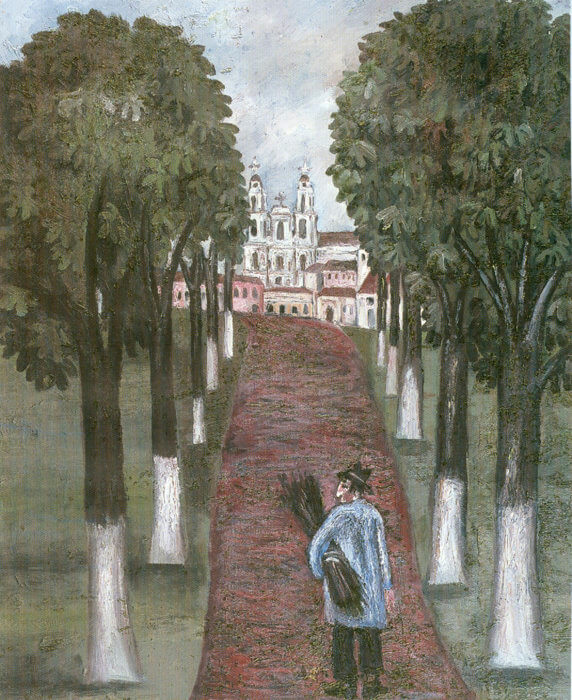
In the 1960s children were respected as ideal artists, and not only for their decorative talent. According to a broad agreement shared by Soviet intellectuals, children’s works reflected an “ingenuous” and direct vision of the world, a vision that was not corrected by social conventions. This is why professionals who wanted to bring the same impact of a fresh vision into their works were turning to their own childish memories and experiences. Victor Kalinin (b. 1946), a Moscow painter with Altai origins, said that his artistic mission was to tell about the world he knew in his childhood and to represent this world in an adequate form. [19] Kalinin did not depict genre scenes, as an academic master would have done. Instead, he created images retrieved from the depth of his memory, as they had been interpreted and preserved by his childish mind. This is why his paintings show a combination of historically truthful images with Altai icons and stylistic folk art.
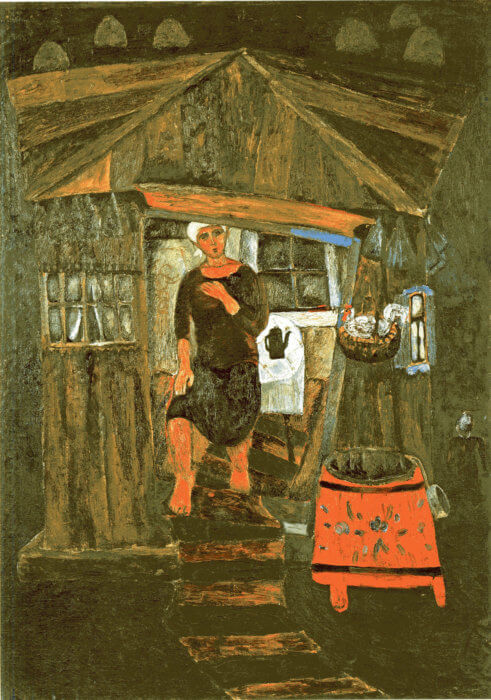
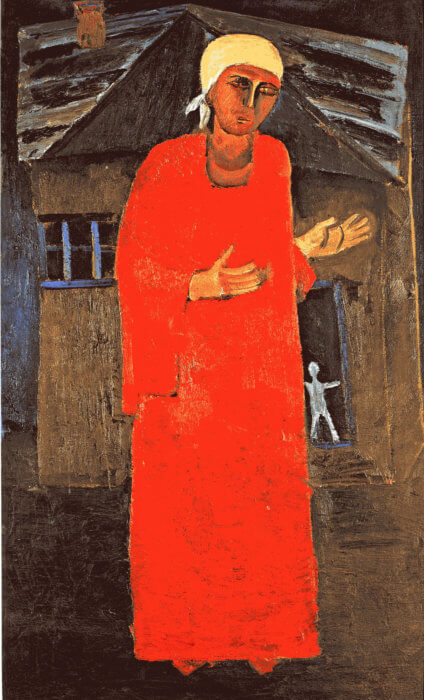
Kalinin’s contemporary, Eugeny Rastorguev (1920–2009), put his memoirs into the shape of a fantastic world that he named Gorodets after his native town, which was famous for its craftsmen. Traditional decorations of spinning wheels inspired Rastorguev to invent his own artistic language. In his notebooks, the artist often emphasized the uniqueness of his experience in opposition to life in Moscow, which seemed to him to be quite humdrum and official. Rastorguev declared escapism to be his art credo:
It is a great happiness to escape [to my world] and to slam the door. Here I am surrounded by a loud gang of characters: queer for the life, but well-done and plastic on the canvas. And all of everyday life with its global problems and sorrows peels off as a husk, because, actually, all these problems are not worth a whoop. [22]
The invented Gorodets world did not have much in common with its historic prototype. It was free of conflicts, and of villains and riffraff, but also of any business, responsibility, and troubles. Its heroes were the opposite of those of official Soviet ideology, which glorified a hard-working, well-organized man and the idea of labor. Rastorguev, as well as many of his contemporaries, wanted to appreciate man as he was, instead of evaluating him by his social status or success.
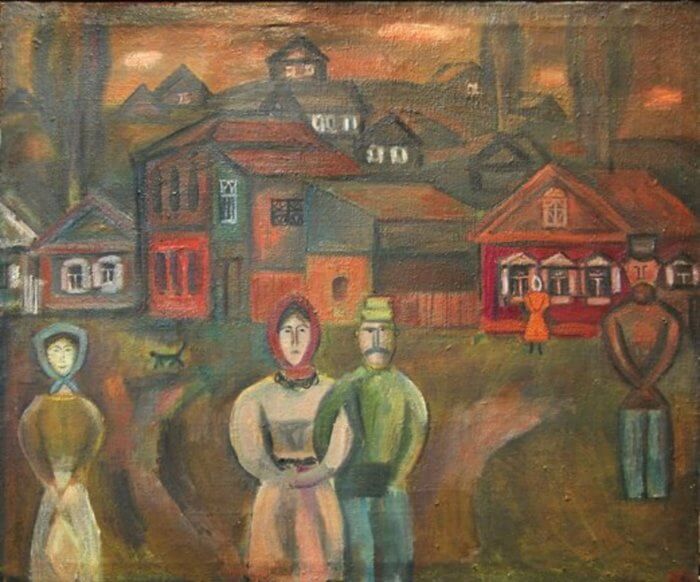
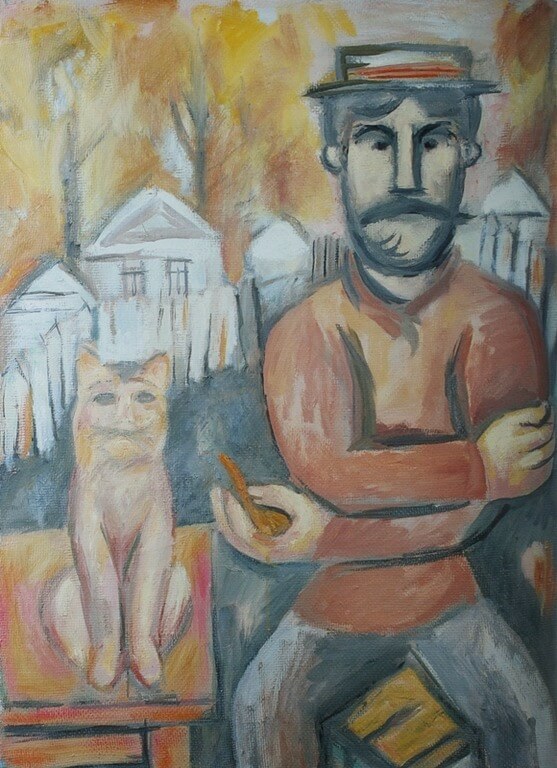
One more author who should be mentioned in this context is Viktor Popkov (1932–74). In the mid 1960s, Popkov made a series of paintings dedicated to soldiers’ widows, poor peasant women who suffered the Second World War and who were exhausted by their hard work. The last piece in the series was named “Old Anisya was a good woman,” and represented rural funerals. Breaking with academic rules of painting, Popkov placed his characters on the flat surface of the canvas and constructed the composition using the rhythm of the bright red spots. The characters’ faces were painted in a laconic manner. Using a large-scale format common for official historic paintings, Popkov depicted the funeral of the unknown Anysia, about whom all we know is that she was an old and “good woman.” The event depicted is granted importance because of the likeness between the composition of this picture, and the traditional composition of the Dormition in Russian medieval icons.
Popkov viewed life as a natural phenomenon. His funerals are depicted against various scenes of everyday life. In the background there are two groups of people occupied with their habitual activities: a shepherd pasturing his herd, and peasants working with spades. Man’s exit from this world, as well as his presence in it, are treated as a part of an eternal circle of life, without any drama or pathos.
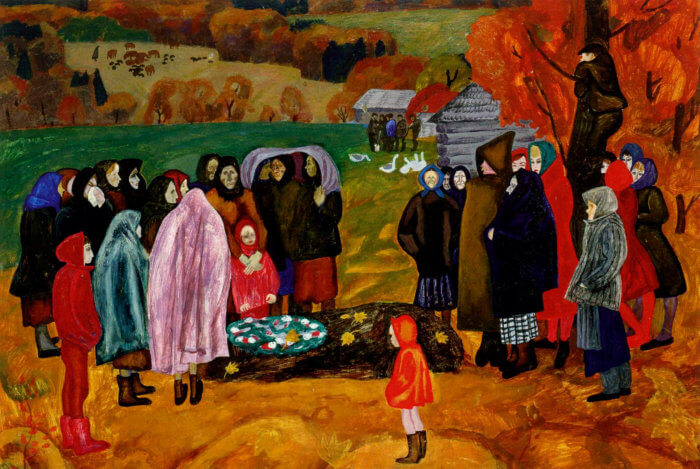
Life as it is, so different from the official idea of the Communism construction, became the main theme of Soviet painting in the 1960s and 1970s. Artists plunged into the atmosphere of an everyday life full of simple and rather banal activities, such as trips to the market and café, or hanging about town. Instead of depicting labor or demonstrations, they turned to traditional feasts and events from people’s private lives, like the birth of a child or a wedding. Such pictures were created in the decorative manner of the folk art that connected them with the national pre-Soviet tradition.

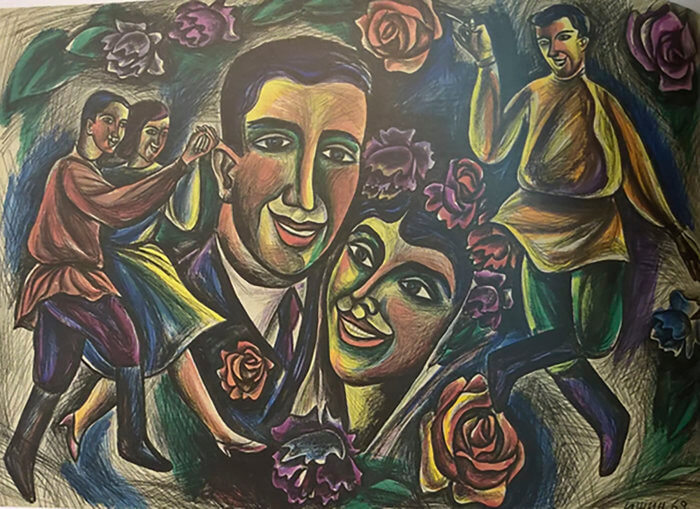
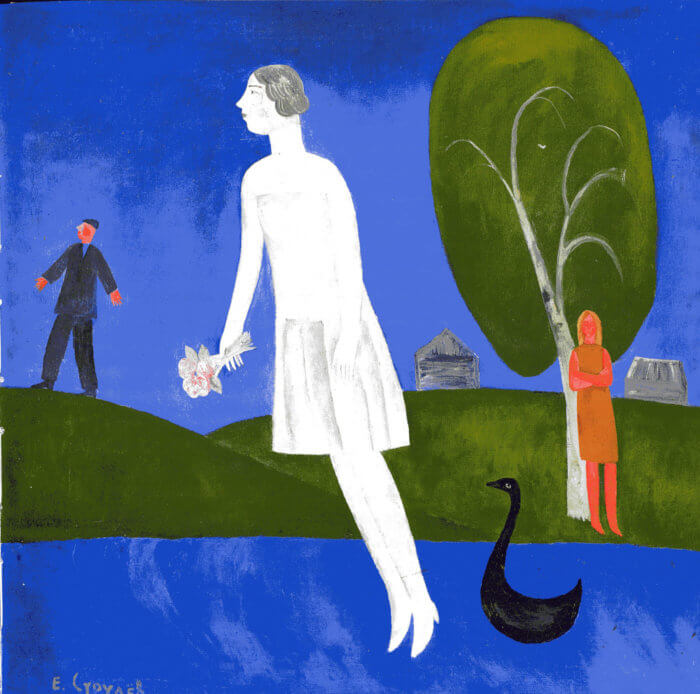
Fine are those things, which were caressed by one’s hands: pictures, old little things which lived long ago and were admired by somebody […] They came up from the past and are drifting over the world, accidently appearing here or there. [30]
So, Grigorieva indirectly opposed traditional handicraft to the industrial aesthetics of standard things common for the Soviet view of reality. She called the heroes of her paintings “alive, kind and silly” and at the same time “eternal.” [31] Thus, the world of a weak and homely man with his everyday joys and cares appears to be very important and firm.
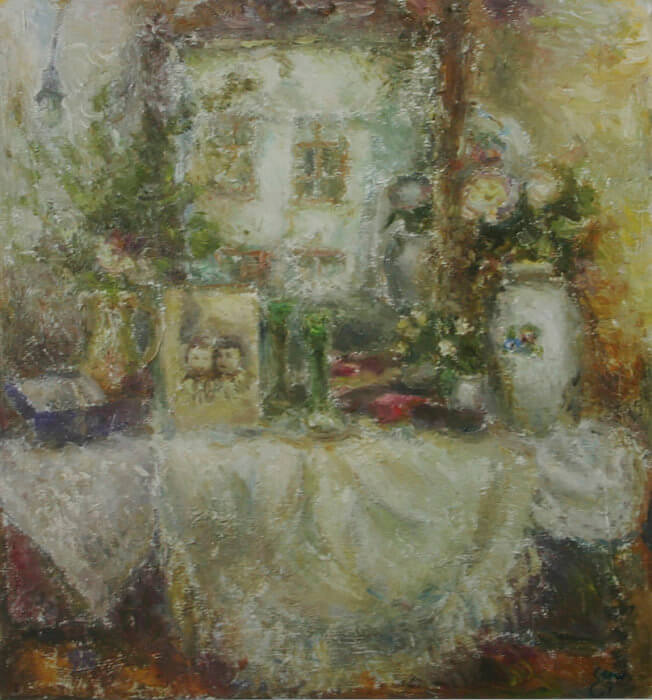
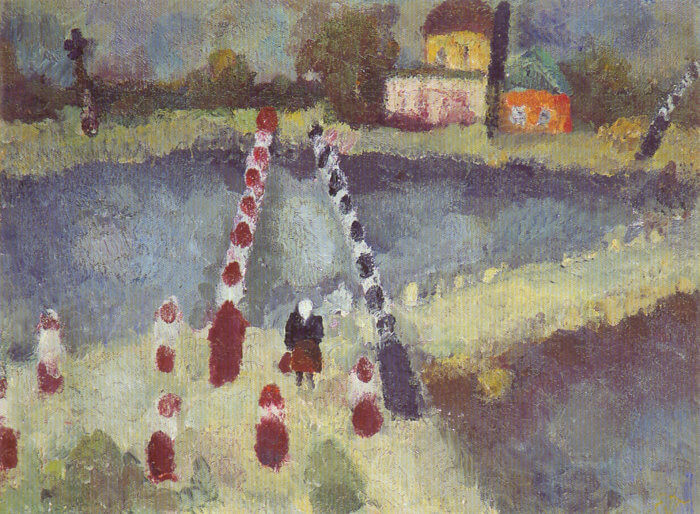
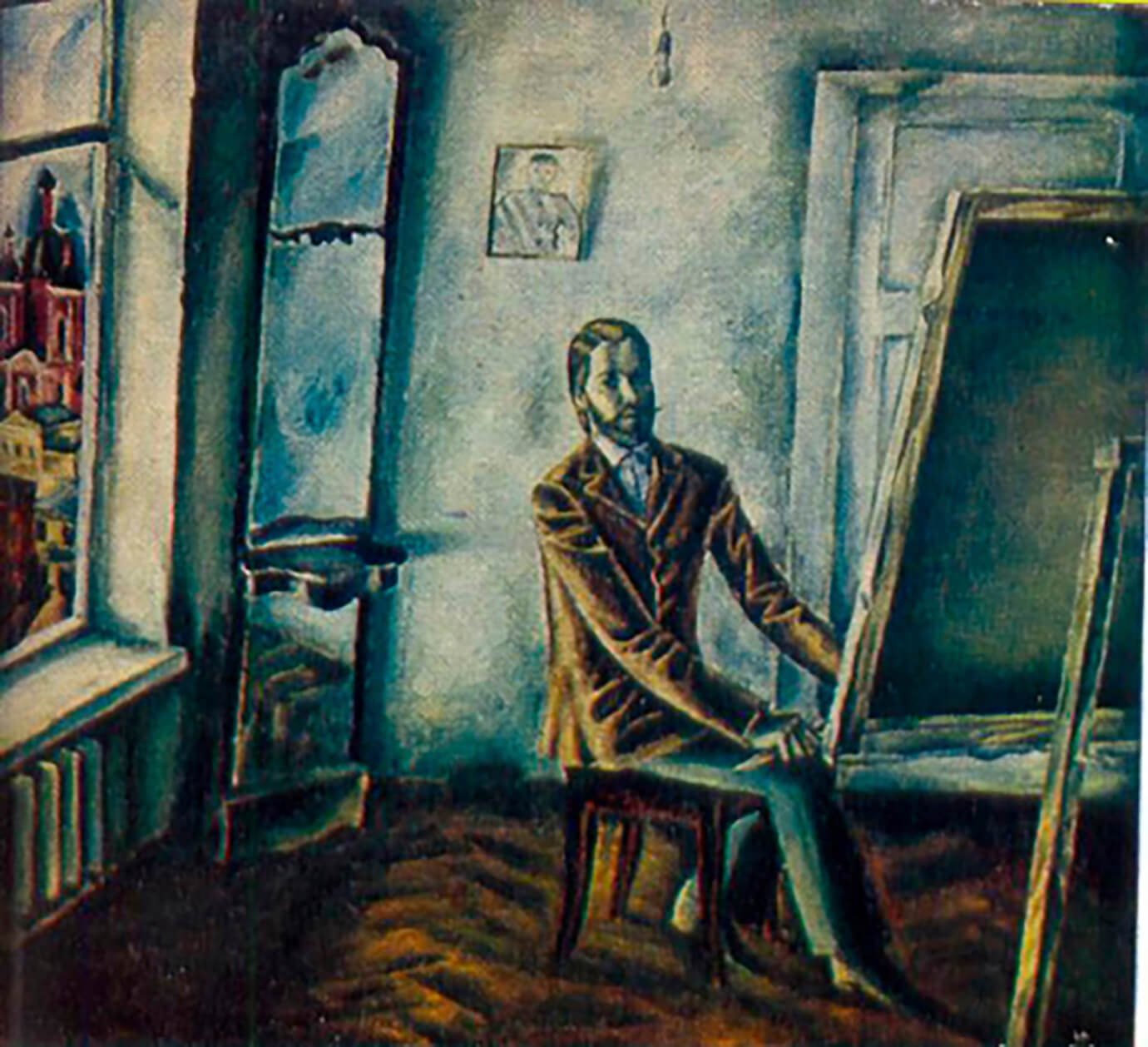
By the end of the 1970s, the movement described in this article expanded within the art scene, and filled Moscow art exhibitions. At the same time, it lost its sharpness and power. The movement, which manifested artists’ rights for decorative experiment and the autonomy of painting from ideology, was not radical. The artists did not have any political ambitions. They compiled different images and ideas, mixed them up and united them on the basis of their private worldview. But the paradox was that this worldview, as well as the artists’ uncritical method of working, was formed by Soviet ideology. In the manner of Communist party speakers, artists were carrying their viewers to a fine and unreal world, where all the inhabitants were anonymous, similar to each other, and absolutely good. Because their art did not speak about real social, political, or cultural problems, it was easily adopted by state ideology.
Nevertheless, we can talk about real accomplishments that the movement achieved. First, the authority and dictates of the academic art system [35] were broken. The borders between easel and decorative painting, professional and non-professional art were disturbed. What’s more, a little queer man, so different from the figure promoted by official standards, became an important hero of art. Finally, Soviet artists gained the right to talk about the importance of individuality, regardless of its social status and collective functions.
Thus, observing this art from an historical perspective, this article argues that it prepared for, and reflected, political changes in thinking, even though it never realized itself in political action. The artists, who felt themselves marginalized by state ideology, expressed the special late Soviet idea of double-mindedness and the strategy of inner mental migration. The artists’ interest in those on the real margins of Soviet culture created a new perception of the multiplicity of Soviet society. After this figurative and semantic shift, there was no going back to the hegemony of Socialist realism. Removal of ideological discourse from the official to the private sphere was a gentle form of protest and, thus, it had a definite political facet and impact.
_How to Cite
Vera Otdelnova. “Marginality as a Space of Freedom: Some Notes on the Popularity of Naïve Art Among Soviet Painters in the 1960s and 1970s.” On_Culture: The Open Journal for the Study of Culture 4 (2017). <http://geb.uni-giessen.de/geb/volltexte/2017/13392/>.
_Endnotes
- [1] See Robert E. Park, “Human Migration and the Marginal Man,” in American Journal of Sociology 33.6 (1928), 881–893.
- [2] See Arlet Farzh and Evgenii Rashkovskii, “Marginaly” [Marginals], in 50/50: Opyt slovaria novogo myshleniia, eds. Iurii Afanas’ev and Mark Ferro (Moscow: Progress Radio, 1989): 143–149.
- [3] See Dirk Krechmar, Politika i kul’tura pri Brezhneve, Andropove i Chernenko 1970–1985 [Politics and Culture in Brezhnev, Andropov and Chernenko Times 1970–1985], trans. M. G. Rathaus (Moscow: AIRO-XX, 1997); Konstantin Sokolov, Hudozhestvennaja kul’tura i vlast’ v posstalinskoj Rossii: Sojuz i bor’ba 1953–1985 [Artistic culture in Russia after Stalin: Union and Fight, 1953–1985] (Saint Petersburg: Nestor-Istorija, 2007).
- [4] See Tomáš Glanc, “Pozor. O vospriiatii vvoda voisk v Chekhoslovakiiu v literaturnykh i gumanitarnykh krugakh,” in Vtorzhenie: Vzgliad iz Rossii. Chekhoslovakiia, avgust 1968 [Invasion: Look from Russia, Czechoslovakia, August 1968], ed. Josef Pazderka (Moscow: Novoe literaturnoe obozrenie, 2017), 141–161.
- [5] Ksenya Bogemskaya, Naivnoe iskusstvo i khudozhestvennaia samodeiatel’nost’ v Rossii 1920–1990e gg. Istoriia i problema kul’turnykh kontekstov [Naïve art and amateur art activities in Russia in the 1920s–1990s. History and a problem of cultural contexts] (PhD diss., State Institute for Art Studies, 2003), 16.
- [6] Ksenya Bogemskaya, Naivnoe.
- [7] See Andrei Erofeev, “Oni okazalis’ epizodicheskimi geroiami” [They were episodical heroes], in Iskusstvo 4 (2012): 48–58.
- [8] Dekorativnoe Iskusstvo SSSR 6 (1970): cover.
- [9] Grigoriy Kapelian, “Samovary” [The Samovars], in Dekorativnoe Iskusstvo SSSR 1 (1968), 24–25.
- [10] See Mikhail Bakhtin, Тvorchestvo Fransua Rable i Narodnaia Kul’tura Srednevekov’ia i Renessansa [The Art of Francois Rabelais and Folk Culture during the Middle Age and Renaissance] (Moscow: Khudozhestvennaia Literatura, 1965).
- [11] Bakhtin, Тvorchestvo, 13.
- [12] Bakhtin, Тvorchestvo, 10.
- [13] Valeriy Prokofiev, “O tryoh urovnyah hudozhestvennoi kulturi Novogo i Noveishego vremeni” [On three levels of art culture of the new and modern age], in Primitiv i ego mesto v kul’ture Novogo i Noveishego vremeni [Primitive and its place in the culture of the new and modern age] (Moscow: Nauka, 1983), 6–29, here: 12.
- [14] Ksenya Bogemskaya, Naivnoe iskusstvo: Elena Volkova [Naïve Art: Elena Volkova] (Moscow: Dmitrii Bulanin, 2001), 7.
- [15] “Transcript of the discussion around the eighth exhibition of young artists,” February 18, 1969, col. 2943, vol. 3, TS. 30, RGALI, Moscow, 2–3.
- [16] “Transcript of the discussion,” 5–8.
- [17] Viktoriia Lebedeva, “Tikhaia revoliutsiia v zhivopisi” [Quiet Revolution in Painting], in Khudozhestvennaia zhizn’ Rossii 70kh godov kak sistemnoe tseloe [Artistic life in Russia in the 1970s as a system] (Moscow: Aleteiia, 2001), 202.
- [18] Alexander Morozov, Moya Sovremennost’ [My Contemporanity] (Moscow: Galart, 2011), 99.
- [19] Interview by the author of this paper with Viktor Kalinin, March 2016; my translation.
- [20] Viktor Kalinin, Paintings (Saint Petersburg: Palace Edition, 2009), 38.
- [21] Viktor Kalinin, Paintings, 37.
- [22] Evgeny Rastorguev, Zapiski iz zazerka’’ia [Notes through the Looking Glass] (Moscow: RA, 1998), 24.
- [23] Evgeny Rastorguev, Zapiski, 24.
- [24] “Eugeniy Rastorguev: Gallery of Images” (2015), accessed September 28, 2017, <http://cultobzor.ru/2015/02/evgeniy-rastorguev-gallery/>.
- [25] “Old Anisya was a Good Woman,” accessed September 28, 2017, <http://www.art-catalog.ru/picture.php?id_picture=21604>.
- [26] Oleg Vukolov, Paintings (Moscow: Sovetskii Khudozhnik, 1977), 19.
- [27] Alexander Ishin, Paintings (Moscow, 2013), 7.
- [28] Eugeny Strulev, Paintings (Moscow, 2014), 21.
- [29] Ekaterina Grigorieva, Iz zapisei khudozhnika Grigor’evoi Ekateriny Evgenievny [From the notes of the artist Grigorieva Ekaterina Evgenievna], in id., Vystavochnyi zal Kovcheg [Catalog of the Exhibition] (Moscow: Kovcheg, 1999), 4.
- [30] Ekaterina Grigorieva, Iz zapisei, 6.
- [31] Ekaterina Grigorieva, Iz zapisei, 6.
- [32] “Ekaterina Grigorieva. Gallery of Images” (2016), accessed September 24, 2017, <http://cultobzor.ru/2016/02/ekaterina-grigoreva-gallery/>.
- [33] “Ekaterina Grigorieva. Gallery of Images.”
- [34] Vladislav Rozhnev, Paintings (Moscow: Sovetskii Khudozhnik, 1980), 35.
- [35] With the term ‘academic art’ I mean the type of art that was championed by a very conservative art academy and was taught in the Soviet art institutions. The features of “academic art” were strictly realistic form; narrative — usually ideological — subject; and large-scaled composition with multiple figures and a main hero in the center. This kind of art had been the standard from the late 1940s until the mid-1950s and was promoted by state officials during the entire Soviet era.



